As a newer series, minted only in the late 90s, the 1998 Quarter is not on the list of the most sought-after coins. That said, there are caveats you might want to know if you ever stumble upon this coin series. With this 1998 Quarter Value Guide, we’ll tell you all you need to learn!
1998 Quarter Value Summary
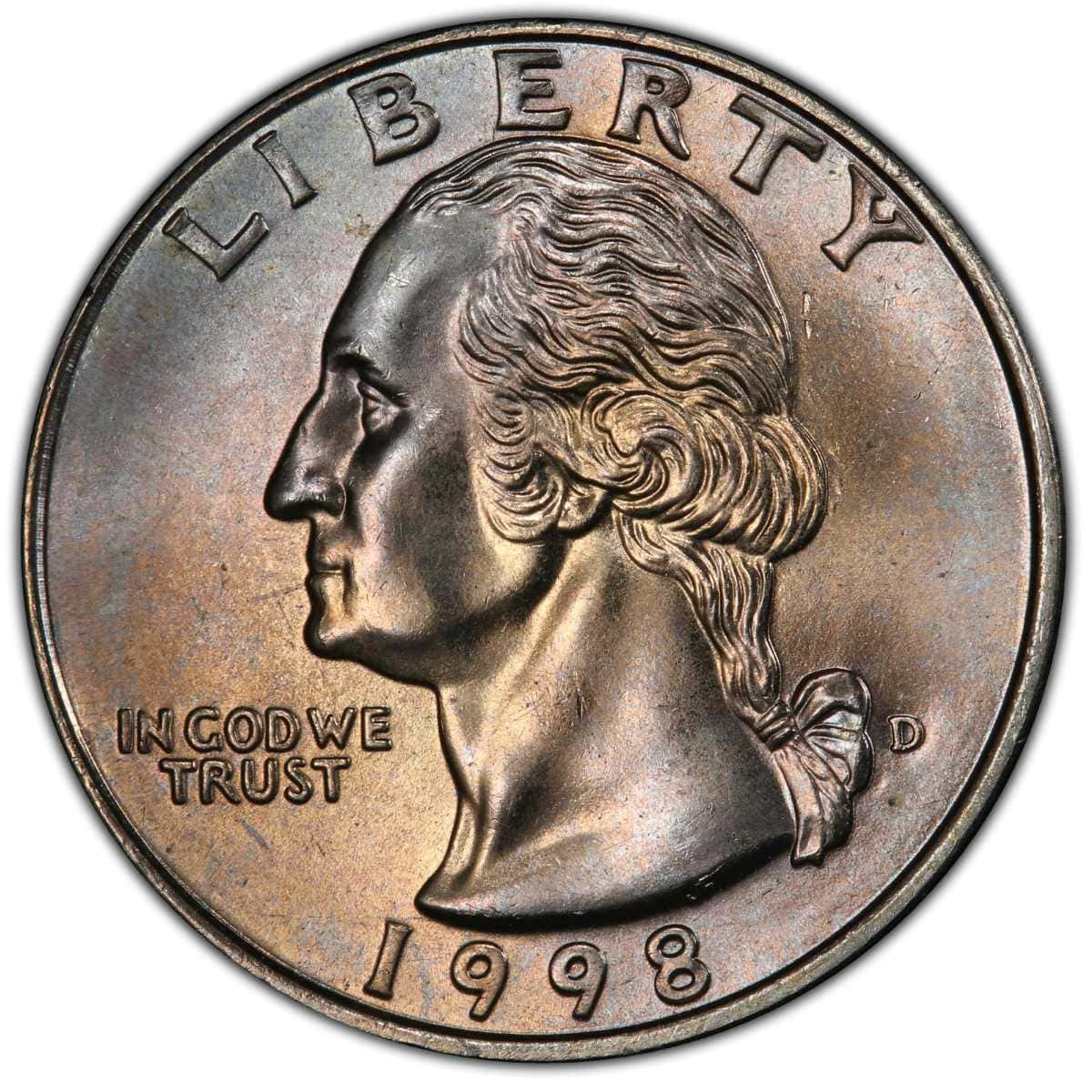
Below is the estimated value for the 1998 Quarter according to our research. With more than 1.7 billion produced and the coin being new, it’s no surprise that this coin has a lower market value.
| Mint Location | Mintage | Coin Series | Estimated Value |
| Philadelphia | 896,268,000 | 1998 P 25C MS | $0.30 to $375.00 |
| Denver | 821,000,000 | 1998 D 25C MS | $0.30 to $100.00 |
| 1998 D 25C MS-PL | $20.00 to $400.00 | ||
| San Francisco | 2,965,299 | 1998 S CLAD 25C PF UC | $4.90 to $45.00 |
| 878,792 | 1998 S SILVER 25C PF UC | $4.90 to $65.00 |
The circulated regular strike quarters go for $0.30, regardless of the mint location. The Philadelphia Mint has a higher estimate for uncirculated coins at $350. Meanwhile, the D Quarter is only at $100.
However, the proof-like version of the Denver Mint has a higher starting price at $20. It also has the highest estimated worth of $490 for the highest uncirculated state.
Both the proof coin starts at $4.90. Silver has a higher value at $65 to clad’s $45.
1998 Quarter Details
- Category: Washington Quarters
- Weight: 5.67g
- Diameter: 24.3mm
- Composition: Copper-Nickel Clad, Copper Core
- Obverse and Reverse Designer: John Flanagan
- Edge: Reeded
The coins still bear the original obverse design created by John Flanagan in 1934. It features the portrait of the country’s first leader, George Washington, facing left.

The word “LIBERTY” is inscribed above Washington’s head along the coin’s rim. Below the bust, you’ll find the year of minting, 1998. Additionally, the motto “IN GOD WE TRUST” can be found to the left, and the mintmark on the right.
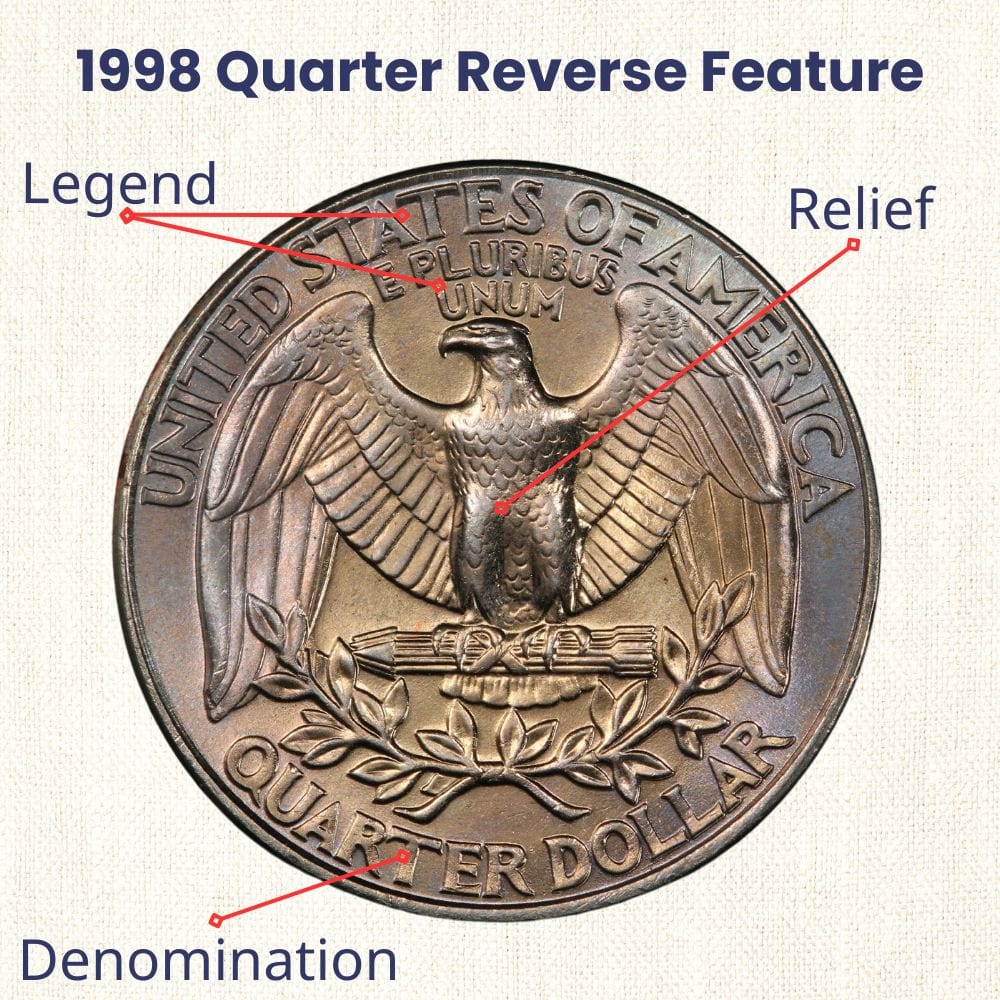
The reverse features an eagle with expanded wings perched upon a sheaf of arrows. Below the eagle, two olive branches. The elements are meant to symbolize freedom and wisdom.
Written above the eagle is the Latin phrase “E PLURIBUS UNUM,” meaning “Out of many, one.” Finally, curving along the top half of the coin’s edge is the country’s name, “UNITED STATES OF AMERICA.” The denomination “QUARTER DOLLAR” can be found at the base of the coin.
How Much is a 1998 Quarter?
The year 1998 marks the last mintage of the original Washington Quarters. So, it’s no surprise that this year produced a lot of coins. Unfortunately, being the last mintage did not give it much increase in value.
In fact, the lower quality dies due to old age might have diminished the value of this coin as there are scarce instances of proof like coins.
| 1998 Regular Strike Quarter Value List | ||
| Grading | 1998 P Quarter | 1998 D Quarter |
| G to XF | $0.30 | $0.30 |
| MS 50 | $0.40 | $0.40 |
| MS 58 | $0.75 | $0.75 |
| MS 60 | $1.50 | $1.50 |
| MS 61 | $2.50 | $2.50 |
| MS 62 | $3.50 | $3.50 |
| MS 63 | $5.00 | $5.00 |
| MS 64 | $7.50 | $7.50 |
| MS 65 | $10.00 | $10.00 |
| MS 66 | $15.00 | $37.50 |
| MS 67 | $55.00 | $100.00 |
| MS 68 | $375.00 | / |
There is not much difference when it comes to the value of the 1998 Quarter, regardless of the mint location. From the circulated grade to MS-65, they have the same estimated price. It’s no surprise, as they minted about the same amount of more than 800 million coins.
The difference starts to show at the MS-66 and upgrading. The D Quarter doubles the value of the P ones with the grades MS-66 and MS-67. Meanwhile, there are no estimates for the MS-68 D Quarter.
1998 P Quarter Value and Auction Record
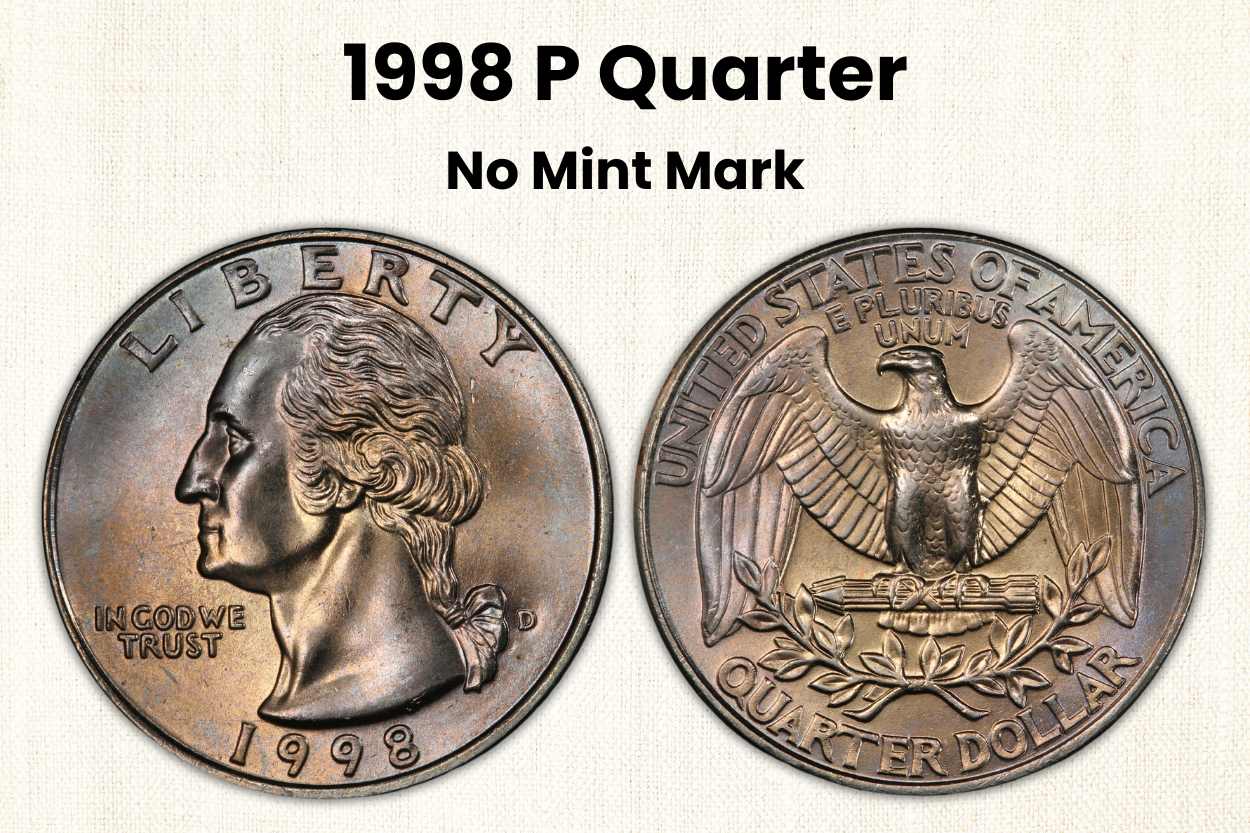
In 1998, the Philadelphia Mint produced a whopping 896 million Washington quarters. It’s common, so this specific coin is not considered to be very valuable among collectors because it was mass-produced and did not hold any significant historical significance.
The 1998 P Quarter in circulation is only worth $0.30, with the coins up to MS-66 not increasing that much in value. However, there is a jump in the MS-67 with a price of $55. The highest value is $375 for the MS-68 1998 P Quarter.
1998 D Quarter Value and Auction Record
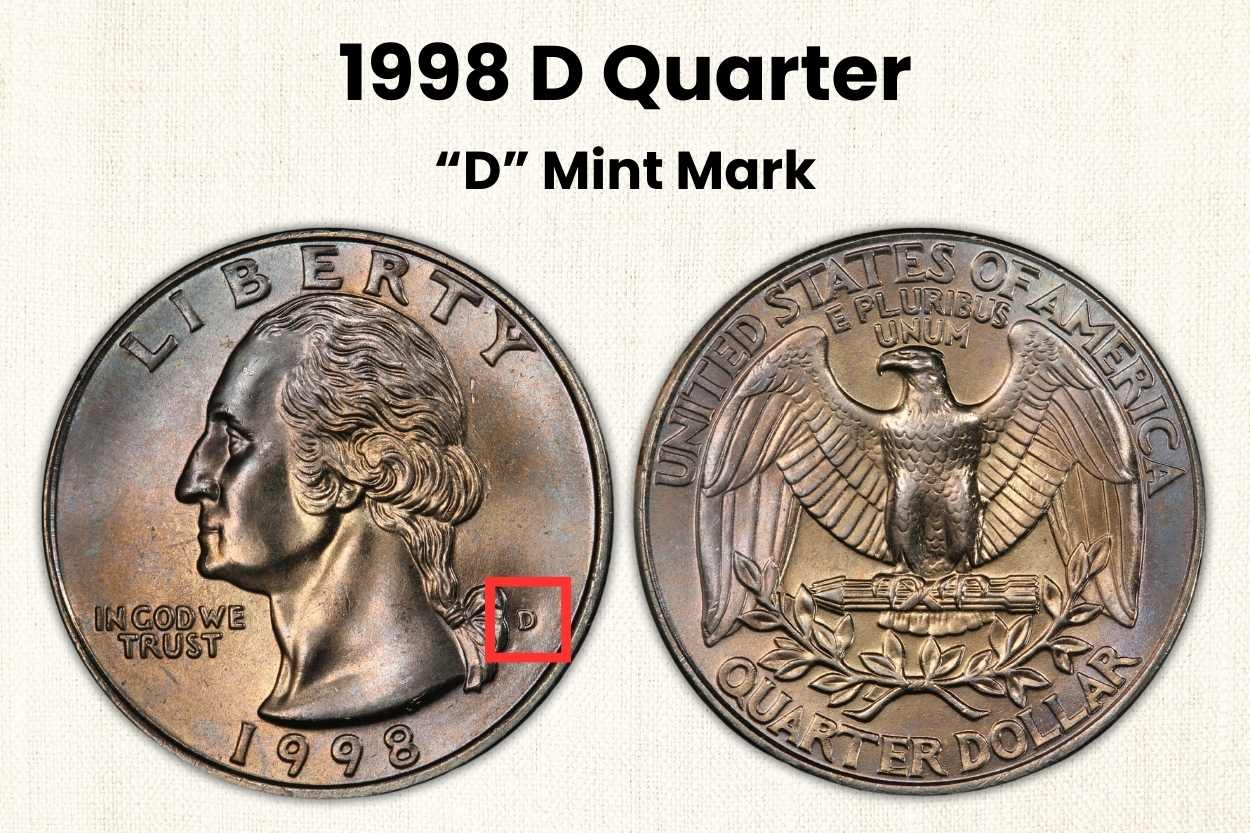
Back in 1998, the Denver Mint made around 821 million quarters, which is pretty close to the amount produced by the Philadelphia Mint. Because of this extensive production and the fact that it’s a relatively recent coin, you can find this quarter without much difficulty, even in excellent uncirculated condition. You can easily distinguish a 1998 D Quarter with its ‘D’ mintmark.
It has the same value of $0.30 for the circulated grade. However, the grading for the D Quarter only ends at MS-67 in comparison to the MS-68 of the P Quarter. Its highest price for the regular strike is $100.
| 1998 D Quarter Prooflike Value List | |
| Grading | 1998 MS PL |
| PF 64 | $20.00 |
| PF 65 | $35.00 |
| PF 66 | $160.00 |
| PF 67 | $400.00 |
That said, there is a striking character for the D Quarter: Prooflike or PL. It refers to the coins that have a higher, almost-proof-like quality. It has a better strike and more luster in comparison to regular strike coins. The 1998 D Quarter Prooflike has a price of $20 to $400. The highest estimation in this coin series.
1998 S Quarter Proof Value
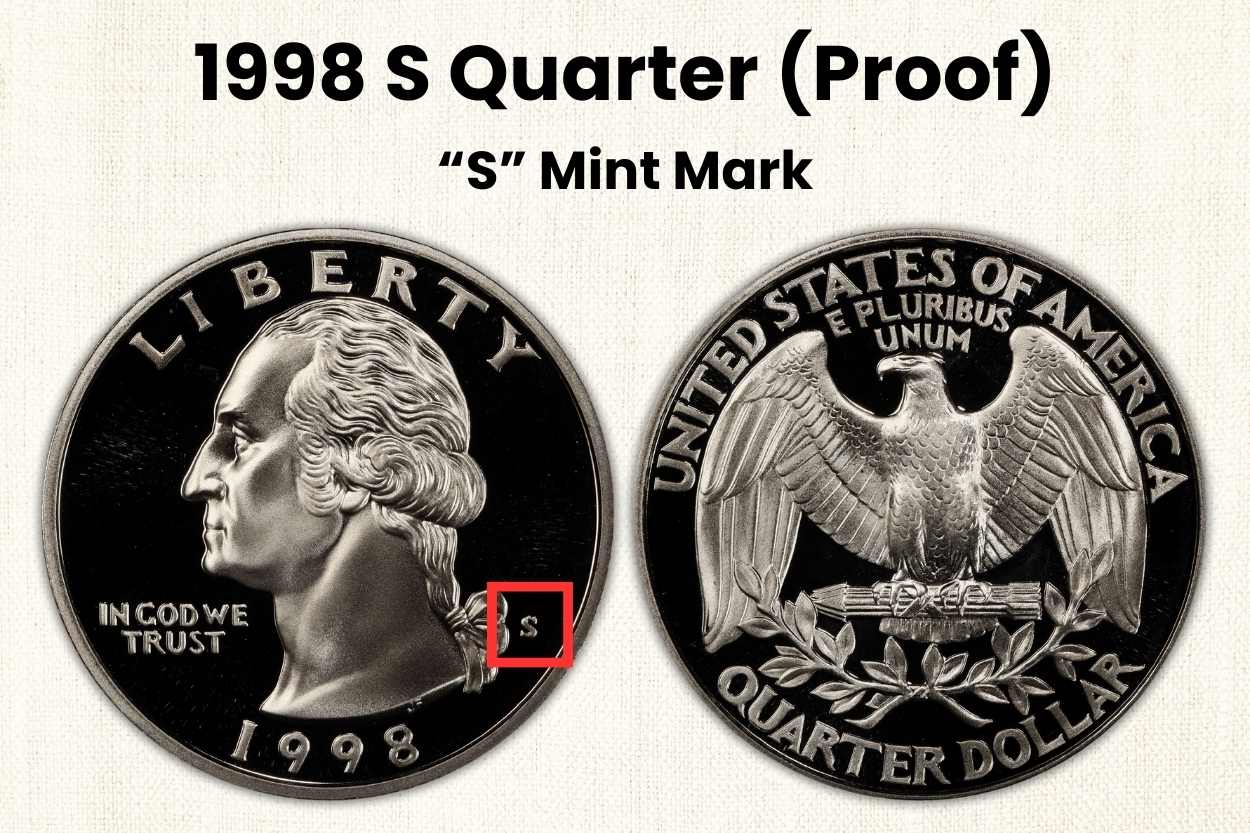
Proof refers to the coins that are made with higher-quality dies. For many quarter series, the proof came from the San Francisco mint. Thus, it bears the ‘S’ mintmark.
For the 1998 proof coins, there are two kinds: clad and silver. Much like the regular strike, the clad coins are made with copper-nickel clad and copper core. Meanwhile, the other is made with silver.
Unfortunately, due to this year being the last mintage, the proof production is not that high quality. It suffers from older die and blanks. Also, it’s minted in such a large quantity, around 3 million in total, that is not a rare commodity.
| 1998 S Proof Quarter Value List | ||
| Grading | 1998 S CLAD Proof | 1998 S SILVER Proof |
| MS 60 | $4.90 | $4.90 |
| MS 61 | $8.00 | $5.00 |
| MS 62 | $9.00 | $5.10 |
| MS 63 | $11.00 | $10.50 |
| MS 64 | $12.00 | $11.00 |
| MS 65 | $13.00 | $12.00 |
| MS 66 | $14.00 | $13.00 |
| MS 67 | $17.00 | $14.00 |
| MS 68 | $20.00 | $16.25 |
| MS 69 | $26.25 | $25.00 |
| MS 70 | $45.00 | $65.00 |
Even with different materials, the proof coin for this year has the same base value of $4.90. Surprisingly, despite being more sought-after in terms of bullion, the clad coin has a higher estimate than the silver ones.
This is due to its lower number. There are fewer 1998 Clad Proof Quarter graded by organizations such as NGC and PCGS.
However, the tables turn at the MS-70 grade, where the 1998 Silver Proof has an estimate of $65. Meanwhile, the 1998 Clad Proof only has $45.
1998 Quater Error Coins
The 1998 Quarter might not have high value in the regular strike or proof coin, but some of these errors can fetch you hundreds and even thousands of dollars! As most of the striking die and hubs from this production are old, it’s not surprising that the 1998 Quarter is ripe with striking and die error.
Some of the common errors from 1998 quarter production are:
1. 1998 Quarter Double Struck Error
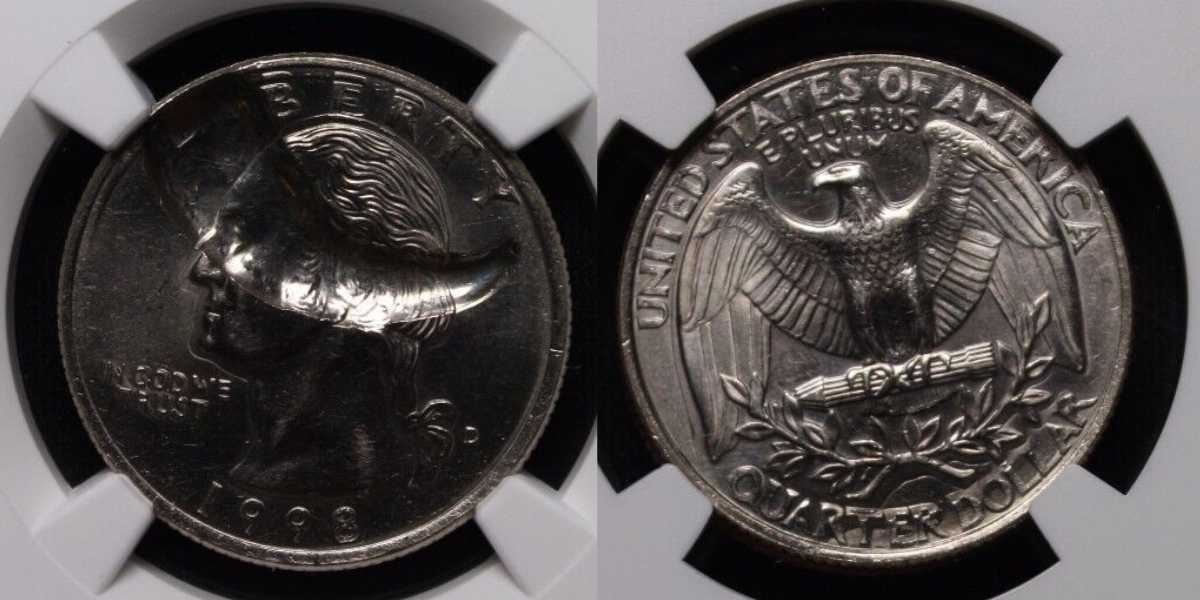
This coin from the Denver Mint; it’s up for $25,567. This is due to a large mix of errors it has, one of them being a double strike!
Double-strikes are coins that have been physically stamped with a marking more than once. This means that the coin was struck by the stamping machine twice, either directly on its intended spot or slightly off-center.
Although the general connotation of a double-struck coin is two strikes, in reality, a coin can be struck an unlimited amount of times. As a general rule, the more noticeable the double stamping is, the higher the coin value.
2. 1998 Quarter Off-Center Error
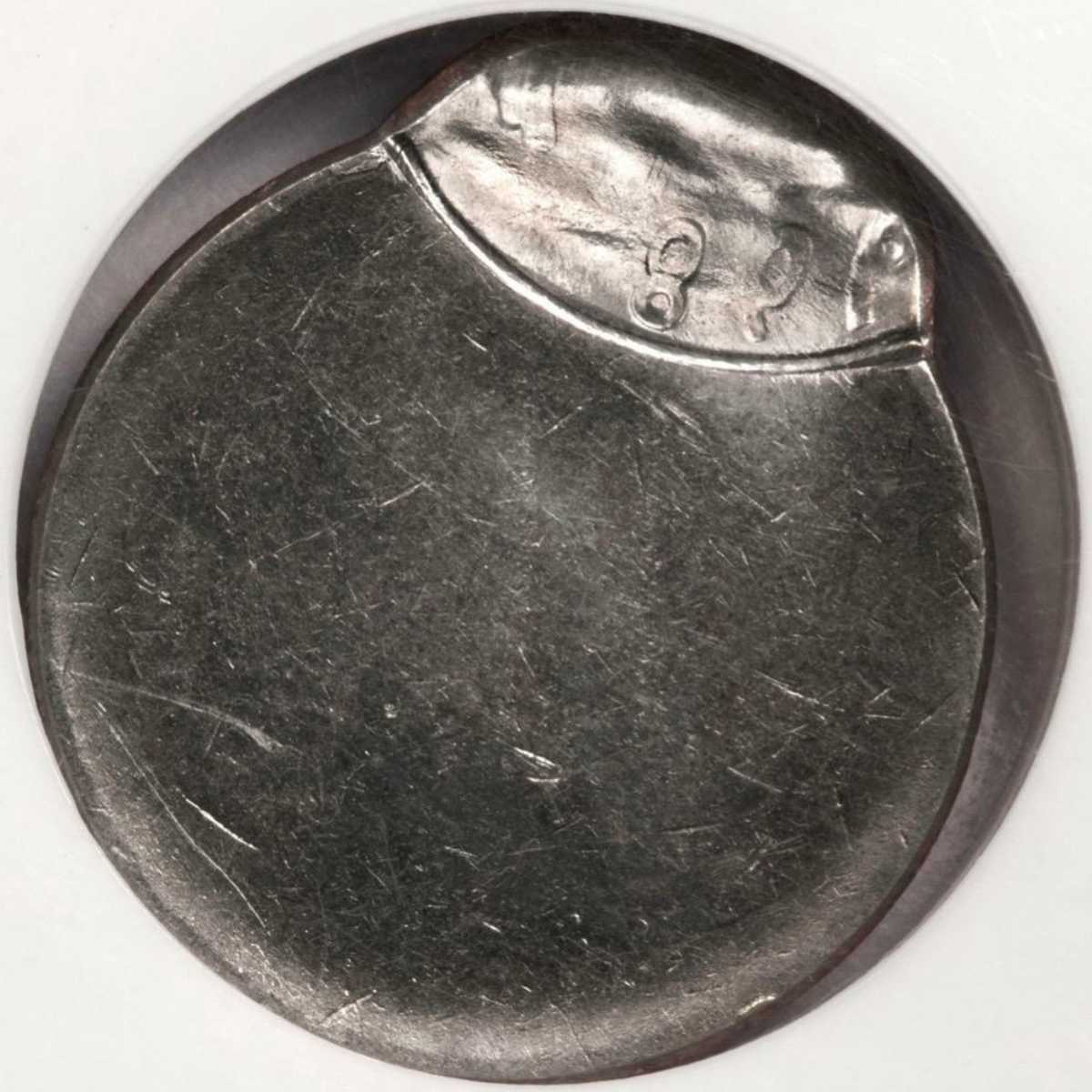
There’s a possibility of an off-center error happening when the machinery isn’t able to correctly place a blank coin between the stamps that create the design. This leads to only some parts of the design being imprinted on the coin instead of it being fully struck. For it to be considered an off-center strike, the engraving must definitely be incomplete, as mentioned earlier.
The off-center error is mainly accompanied by a percentage. Take this 1998 Quarter with 75% off-center error; it’s up in eBay for $879.97. As a rule, the higher the missing portion is, the higher the price.
Another example is this partial off-center coin up for $125. It’s a smaller off-strike, so it has a lower price than the prior example.
3. 1998 Quarter Double Die Error

The coin in the above picture is sold for $400, it has a double die in the mintmark and the ‘In God We Trust’ engraving.
The double die error is very similar in appearance to the double strike ones. While the double strike happens in the striking process, the double die is an error in the coin die itself.
This error is mostly typical with older dies and coin series, where the die itself slowly disintegrates due to repeated striking. However, a double die can also be from a new, but wrongly manufactured coin die.
The value for this error can go from a couple of dollars to well over hundreds. Depending on how many double die error is present.
4. 1998 Missing Clad Quarter Error
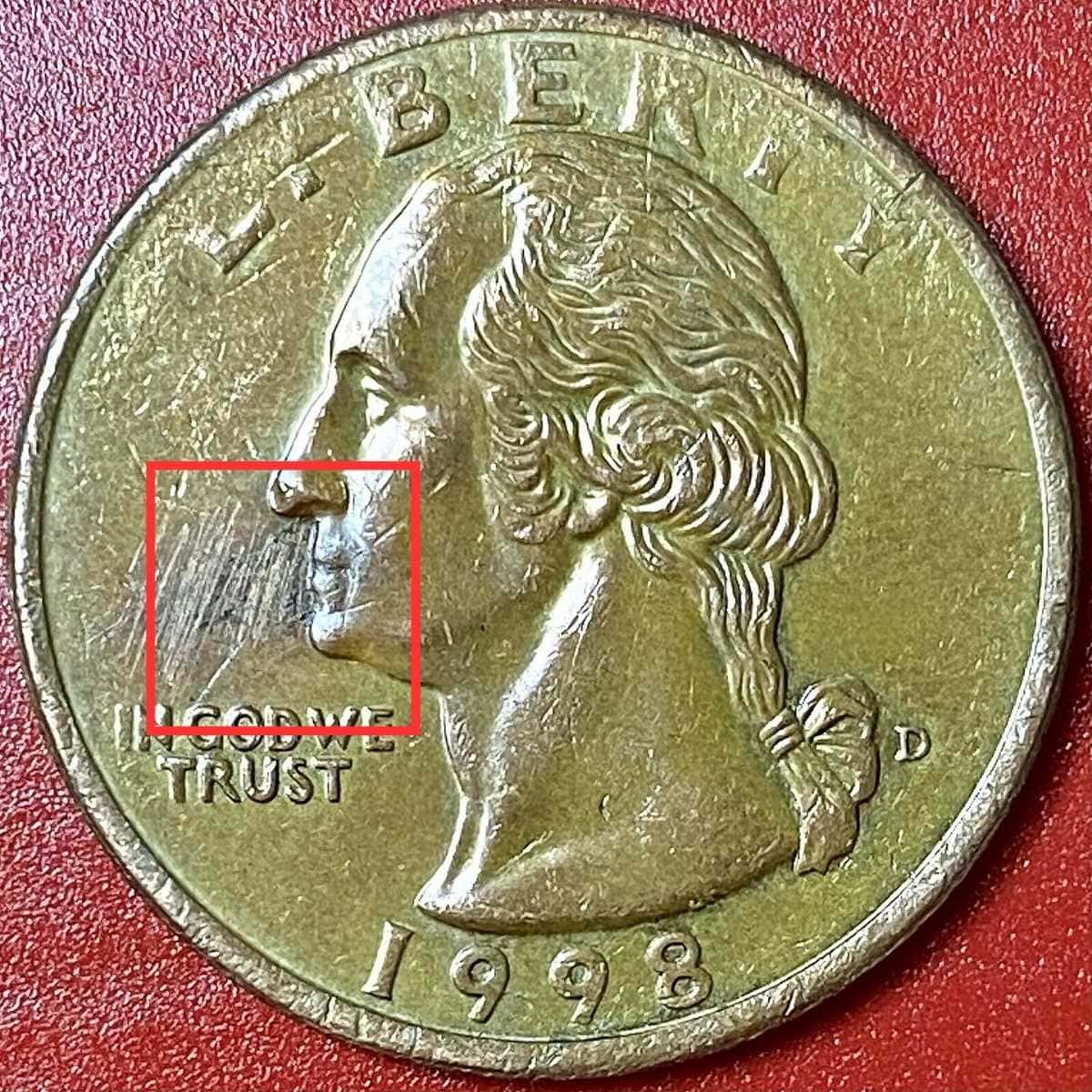
Being a copper-nickel clad, not all layers can be manufactured correctly. Thus, a missing clad is another anticipated error when it comes to these coins. Some just have a partially missing one, while the other has a complete lack of outer clad. This 1998 D Quarter has a missing obverse clad, showcasing its copper core. It’s up for $99!
1998 Quarter Value Grading Based on Four Conditions
One of the best ways to evaluate your coin’s value is by their grades. Here are elements you need to look after to determine your coin’s grade.
Uncirculated State
The uncirculated or MS-60 and up grade is given to those coins that show little to no wear. They are very sought-after, especially when it comes to higher gems such as MS-67 and higher. The telltale signs that your coin is in an uncirculated state are the detail and luster.
Washington’s hair and the eagle feathers will still be intact without any elements melding together. It will also have an excellent shine, even without harsh light.
Extremely Fine State
Although extremely fine grading (XF-40) has some wear, it can be much harder to see by the naked eye. Some of the luster is diminished, although it should still shine under some light. Washington’s hairline can meld into his forehead. Meanwhile, in the reverse, the wings can have less distinct feather lines.
Fine State
The Fine (F-12) still showcases the bigger details. However, the elements are now mostly flattened, with a lot of the shine of the coin gone. It’s primarily used in the market and not as a collectible coin.
Good State
The Good (G-4) grading is amongst the most common ones you’ll find as it came from most circulated coins. The coin appears matte from handling, with the more minor details flat and unrecognizable. Most of the time, the more prominent elements are the only ones easily separated.
In Conclusion
In conclusion, 1998 might be the last one from the Washington Quarters, but it does not increase its price. As this coin is pretty new in the realm of coin collection, it’s an excellent addition if you want a coin that’s easy to find. That said, you’ll need an uncirculated or an error coin for it to be better than the face value!
ORIGINALITY AI: https://app.originality.ai/share/xnrqkce82fgv4ijh

Jenson is a professional numismatist, a dedicated coin collector, a graduate of the College of Business at Oregon State, a life member of the American Numismatic Association (ANA), and an overall coin nerd. He is the founder of Coin Value List.
